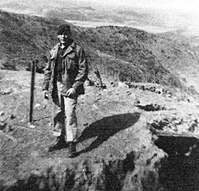The Canadian Contribution
The Korean War

Russ Moses, a Delaware from the Six Nations Reserve, served on HMCS Iroquois during the Korean War. Here he is shown aboard the Prestonian in June 1953. After the war he served with the RCAF, and in the 1960s, hosted the CBC radio program Our Native Land. Moses is the nephew of James Moses, a lieutenant who went missing in action in the Great War. His wife, Helen, is the daughter of Edith Anderson Monture, another First World War Indigenous Veteran. (Russell Moses)
Today we are Canadians, in service to flag, country and Queen under the blue of the sky and the whiteness of fresh water together in the United Nations banner.84
The Response
The Korean War began on June 25, 1950, when thousands of North Korean infantrymen, supported by tanks and aircraft, crossed the 38th Parallel and invaded South Korea. The United Nations (U.N.) Security Council voted to defend the southern republic, and the Canadian Government, headed by Prime Minister Louis St-Laurent, decided to commit a military force. In the end, fewer Canadians would serve in this war than in the two World Wars. However, Canada's contribution to the U.N. forces would be surpassed only by the United States and Great Britain. More than 26,000 Canadians participated during the war, and additional troops assumed peacekeeping roles after the Korea Armistice Agreement was signed.
The first Canadians to serve in the region were naval personnel. Three RCN destroyers sailed in July 1950, followed one month later by a RCAF transport squadron. Coincidentally, two of the RCN ships—HMCS Cayuga and HMCS Sioux—bore the names of First Nations peoples. Later in the war, they were followed by the Nootka, the Iroquois, the Huron and the Haida, plus two other ships. These names were testimony to the respect Indigenous people had earned within the Canadian military establishment, and continued a tradition that had begun in the Second World War. For example, in 1943, five Mi' kmaw from Nova Scotia were honorary guests of Halifax Shipyards Ltd. for the launching of the tribal class destroyer, HMCS Micmac.

Lawrence Martin of Nipigon, Ontario served in both the Second World War and the Korean War. During the Second, he went overseas in 1943 and became a gunner. Here, Cpl. Martin stands over a bunker and trench in Korea (Lawrence Martin).
While this first group of Canadians was assuming military duties, the government was organizing the recruitment of the Canadian Army Special Force (CASF) for Korean service. A brigade group, the CASF was to be raised by voluntary enlistment and trained as part of the regular army.
Late in 1950, agents of the Indian Affairs Branch,85 in keeping with past practice, were asked to keep track of the number of First Nations members who enlisted in the CASF. By March 1951, 73 names had been recorded. A final figure of participants was not reported, however, it is likely that several hundred Indigenous men served on the battlefields and also at sea in an area that had been known, in more peaceful times, as the Land of the Morning Calm.86
- Date modified: